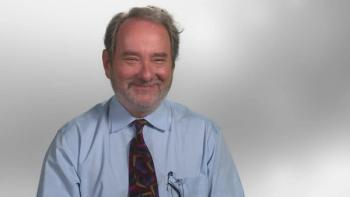
High Blood Pressure Starts at 130/80, New Guidelines Say
The chair of the guidelines committee said just because it's hard to change diet and exercise habits doesn't mean doctors and patients shouldn't try.
High blood pressure is lower than it used to be, following Monday’s presentation of new hypertension guidelines from the American Heart Association (AHA) and the American College of Cardiology (ACC) at the AHA Scientific Sessions in Anaheim, California. The new guidelines mean about half of Americans have high blood pressure, up from one-third of US adults.
The starting point for high blood pressure will now be a systolic blood pressure (BP) of 130 mmHg and a diastolic BP above 80 mmHg, according to the guidelines, which are based on more than 1000 studies published over the past 3 years but are largely driven by results from
Monday’s presenters insisted that even though another 14% of Americans will be diagnosed with hypertension under the revised guidelines, only 1.9% more will need prescriptions because the guidelines rely heavily on lifestyle modification. They also call for more team-based medicine, more reliance on telehealth and “between appointment” monitoring of blood pressure—including getting patients to take their blood pressure at home.
“The patient becomes the center of care,” said Mary Norine Walsh, MD, FACC, president of the ACC, noting the emphasis on lifestyle change instead of medication.
Paul Whelton, MD, MSc, chair of guidelines committee and professor of Global Public Health at Tulane University School of Public Health and Tropical Medicine, acknowledged that getting Americans to change their eating and exercise habits is a tall order. But just because it’s hard doesn’t mean that the nation’s medical community—and patients—shouldn’t try.
“Lifestyle management is a challenge,” Whelton said. “But that’s the underlying issue for high blood pressure, and we have to come to grips with it.”
The guidelines are 106 specific recommendations across 15 sections that cover a range of patients—from those whose systolic BP has just crossed above 120 mmHg to those who are elderly with many comorbidities. AHA and ACC leaders called them the most comprehensive update since the Joint National Committee (JNC) 7 guidelines of 2003. Key changes include:
- The category of prehypertension is eliminated. Systolic BP above 120 mmHg and below 130 mmHg, with diastolic BP below 80 mmHg, is considered elevated. A lifestyle intervention is recommended, and patients should be re-evaluated in 3-6 months.
- Stage 1 hypertension covers systolic BP of 130-139 mmHg and diastolic BP of 80-89 mmHg. Here, however, lifestyle intervention remains the recommendation unless the patient also has elevated risk for atherosclerotic cardiovascular disease. Then, medication is recommended.
- Stage 2 hypertension begins at systolic BP of 140 mmHg and diastolic BP of 90 mmHg. Recommendations call for both lifestyle interventions and medication.
AHA plans a media campaign, including spots produced by the Ad Council, to promote both the new guidelines and the need for Americans to be aware of the dangers of hypertension, especially its lack of symptoms. Presenters were unclear how they planned to resolve inconsistencies between these new recommendations and others endorsed by primary care physicians, who perform most of the day-to-care for hypertension.
And the guidelines are specific about what constitutes a healthy lifestyle: it starts with the DASH diet (Dietary Approaches to Stop Hypertension), which promotes fruits and vegetables, low-fat or nonfat dairy, whole grains, and less than 1500 mg of daily sodium intake. The guidelines also call limiting alcohol to no more than 2 drinks a day for men and no more than 1 per day for women, and exercising at least 30 minutes 3 times per week.
When asked how the guidelines committee arrived at 130 mmHg as its target, Robert Carey, MD, vice-chair of committee and professor of Medicine and dean emeritus, University of Virginia Health System School of Medicine, said the panel weighed going to 120 mmHg but felt that could cause “untoward side effects if we had a lower universal target.”
Finally, the guidelines include recommendations on the proper way to measure blood pressure. There had been some controversy over the SPRINT trial because of the way the measurements were taken—some critics felt they did not resemble the real-world methods of a busy practice (results presented Monday sought to put that to rest). But the guidelines do call for taking a patient’s BP more than once before diagnosing high blood pressure, and the emphasis on out-of-office readings is designed to address “white coat” syndrome—when patients have high readings because they are nervous in the physician’s office.
American Medical Association David O. Barbe, MD, said the group was “renewing its call” for American adults to take steps to get their blood pressure under control.
“High blood pressure can often be managed effectively when patients work with their physician to create a treatment plan that focuses on healthy lifestyle changes such as exercising, eating a healthy diet, reducing salt intake, drinking alcohol in moderation, losing weight if overweight, and using anti-hypertensive medication when needed,” Barbe said in a statement. “We encourage people to take action today to get their blood pressure under control by adopting a treatment plan that can help them prevent the lasting, negative health impacts of uncontrolled high blood pressure, including heart attack and stroke.”
Reference
Whelton PK, Carey RM, Aronow WS, et al. 2017 ACC/AHA/AAPA/ABC/ACPM/APhA/ASH/ASPC/PCNA guideline for the prevention, detection, evaluation and management of high blood pressure in adults: a report of the American College of Cardiology/American Heart Association Task Force on Clinical Practice Guidelines [published online November 13, 2017]. Hypertension. 2017; doi.org/10.1161/HYP.000000000000065.
Newsletter
Stay ahead of policy, cost, and value—subscribe to AJMC for expert insights at the intersection of clinical care and health economics.









































